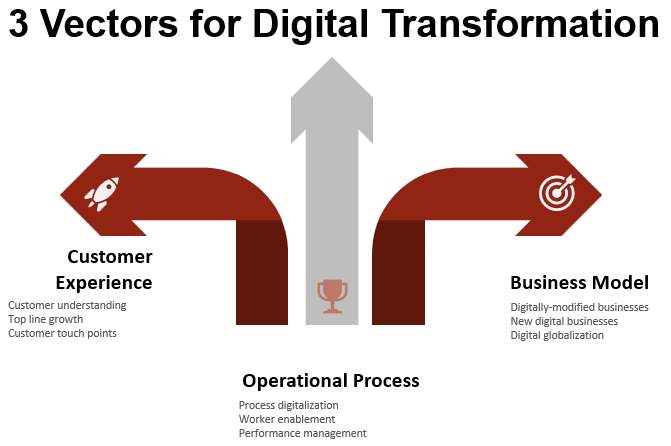The tech innovations of the last decade are nothing short of astonishing, but they’re just the primer of what’s to come. What are the gaps business leaders must close to thrive in the digital age? TSI takes a look.
Caesars Entertainment – a world-leading gaming company, which runs many hotels, casinos, and related businesses – creates special target offers for customers with precision. If you have been at one end of the casino for a while, they will send you a coupon for a restaurant in that part, and if half an hour later you haven’t used it, they will send you another coupon for a cheaper restaurant in that part. From personalizing your stay to determining how you would be greeted on your arrival – they use their data for it all. Should you be having an unlucky day, they will offer you a free dinner that may lighten your mood to sit down at the table again, else, you may leave and never come back again.
Caesars is using technology to improve experience for not only whales (parlance for big spenders) but for a larger group of customers constituting middle of the market – a segment otherwise missed by most in the industry.
There is no question if technology can improve performance. It’s a given. Technology holds the power to radically transform businesses – regardless of the industry or geography. It, however, needs a clear vision of a strategist to wield its true power.
What does digital transformation entail? Why sometimes even the sincerest of efforts lead to disappointing results? And more importantly, when technology transformations succeed?
A survey of the CEOs, directors, and senior executives conducted by Protivit Inc. revealed that nearly 70% of the digital transformation initiatives failed to reach their intended goals in 2018. Additionally, of the USD 1.3 trillion spent on tech transformation in the same year, as good as USD 900 billion went to waste.
A majority part of the success or failure of digital transformation efforts lies in thought. Those who transform quickly and successfully don’t think of technology as a problem to keep pace with, but as an opportunity to transform and get far better results.
Tear down these two mental barriers to bridge the gap between “where you want to be” and “where you are.”
Digital transformation is often an afterthought for companies. They wait to act unless it becomes absolutely necessary. They may first want to gain certainty of the need for action or may believe changes along technological lines is not for their industry, but for others. Then some may lack the leadership to bring tech innovation, or privacy could be their excuse for inaction.
Whatever the reason, as they look for justifications to not act, competitors ever wait.
The result? They are left with basic siloed digital capabilities – framed in the aftermath of life or death situation for the business – unable to make a holistic impact amid their “if-it-ain’t-broke’don’t-fix-it” attitude.
Both of those who are late and who are quick in adopting digital capabilities make the mistake of overlooking the “transformation” aspect.
Investment in technology isn’t limited to creating a next mobile site or having an active social presence, but really understanding how your customers experience your product/services, and how you can drive revenue better.
While you may acquire every flashy technology in the town, the result could be a wide mix of incompatible processes and technologies that may give an impression of progress, but it rather limits and even wastes opportunities.
A unified view of operations is a must to lead a coordinated strike to archaic processes and systems. The bests of companies are transforming everything in their back. Others are just undertaking targeted technology changes.
You need a data analytics or machine learning strategy? Perhaps. However, for any digital transformation to be successful, it should be guided by a unified broader business strategy.
Consultants, strategists, managers, and even seasoned executives often have specific tools in mind when thinking implementation of digital changes. But, to improve organizational performance, the key is to be able to integrate these tools and data to make better decisions. When thinking transformation, synergize your efforts across three interconnected vectors, with nine domains of activities (see below).

Source: Bonnet, McAfee, and Westerman (2021)
Each vector is important on its own and influences others. Many executives combine operational process and customer experience to bring new business model innovations that may extend the existing business model or may depart from it substantially, like Nike’s FuelBand, and digital story of Asian Paints.
Tech investment boom and adoption of digital technologies during the COVID crisis have combined to overcome organizational inertia and neutralize previously perceived barriers of tech immaturity and workforce opposition to change.
At issue is the leadership side of technology. The answer to what technology should you imbibe is important, but even more important is the question of vision. A business strategy framed around a clear vision of “what the company is trying to achieve through technology” is paramount for success.
And the most effective and proven approach to lead digital vision is from top-to-down, which means senior executives and strategists must join the front lines and get their hands dirty to interlock technology and business strategy.
Software, hardware, data, and networks are stampeding the business world. Move from disconnected tech experiments to an orderly approach to digital strategy with advanced TSI certifications.

CredBadge™ is a proprietary, secure, digital badging platform that provides for seamless authentication and verification of credentials across digital media worldwide.
CredBadge™ powered credentials ensure that professionals can showcase and verify their qualifications and credentials across all digital platforms, and at any time, across the planet.

Keep yourself informed on the latest updates and information about business strategy by subscribing to our newsletter.